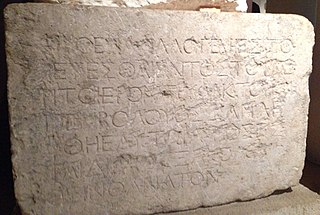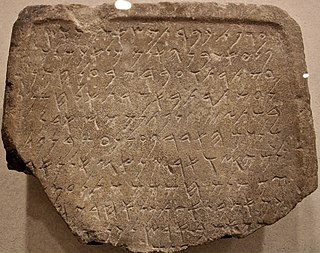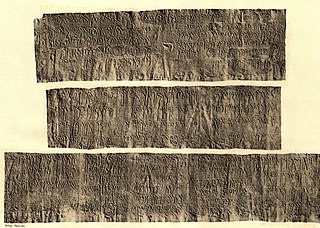
Byblos, also known as Jebeil, Jbeil or Jubayl, is an ancient city in the Keserwan-Jbeil Governorate of Lebanon. The area is believed to have been first settled between 8800 and 7000 BC and continuously inhabited since 5000 BC. During its history, Byblos was part of numerous cultures including Egyptian, Phoenician, Assyrian, Persian, Hellenistic, Roman, Genoese, Mamluk and Ottoman. Urbanisation is thought to have begun during the third millennium BC and it developed into a city making it one of the oldest cities in the world. It is a UNESCO World Heritage Site.

Charles-Jean-Melchior, Marquis de Vogüé was a French archaeologist, diplomat, and member of the Académie française in seat 18.

Jean Antoine Letronne was a French archaeologist.
Nathalie Beaux-Grimal is a French Egyptologist, a research associate at the Collège de France and the French Institute of Oriental Archaeology in Cairo (IFAO).

The Temple Warning inscription, also known as the Temple Balustrade inscription or the Soreg inscription, is an inscription that hung along the balustrade outside the Sanctuary of the Second Temple in Jerusalem. Two of these tablets have been found. The inscription was a warning to pagan visitors to the temple not to proceed further. Both Greek and Latin inscriptions on the temple's balustrade served as warnings to pagan visitors not to proceed under penalty of death.
Pierre Amandry was a French hellenist, especially interested in ancient Greece and its relationships with south-west Asia. He was born at Troyes on December 31, 1912, and died in Paris on February 21, 2006. A large part of his work was on the site of Delphi, excavated by the French School at Athens, of which he was secretary general from 1941 to 1948 and director from 1969 to 1981.

Aimé Vingtrinier was a French printer, writer, amateur historian, figure of the 19th-century scholar.

Umm Al Amad, or Umm el 'Amed or al Auamid or el-Awamid, is an Hellenistic period archaeological site near the town of Naqoura in Lebanon. It was discovered by Europeans in the 1770s, and was excavated in 1861. It is one of the most excavated archaeological sites in the Phoenician heartland.
The Thrones of Astarte are approximately a dozen ex-voto "cherubim" thrones found in ancient Phoenician temples in Lebanon, in particular in areas around Sidon, Tyre and Umm al-Amad. Many of the thrones are similarly styled, flanked by cherubim-headed winged lions on either side. Images of the thrones are found in Phoenician sites around the Mediterranean, including an ivory plaque from Tel Megiddo (Israel), a relief from Hadrumetum (Tunisia) and a scarab from Tharros (Italy).

The Ma'sub inscription is a Phoenician-language inscription found at Khirbet Ma'sub near Al-Bassa. The inscription is from 222/21 BC. Written in Phoenician script, it is also known as KAI 19.

The Corpus Inscriptionum Semiticarum is a collection of ancient inscriptions in Semitic languages produced since the end of 2nd millennium BC until the rise of Islam. It was published in Latin. In a note recovered after his death, Ernest Renan stated that: "Of all I have done, it is the Corpus I like the most."

The Yehawmilk stele, de Clercq stele, or Byblos stele, also known as KAI 10 and CIS I 1, is a Phoenician inscription from c.450 BC found in Byblos at the end of Ernest Renan's Mission de Phénicie. Yehawmilk, king of Byblos, dedicated the stele to the city’s protective goddess Ba'alat Gebal.

The Baalshillem Temple Boy, or Ba'al Sillem Temple Boy, is a votive statue of a "temple boy" with a Phoenician inscription known as KAI 281. It was found along with a number of other votive statues of children near the canal in the Temple of Eshmun in 1963-64 by Maurice Dunand, and is currently in the National Museum of Beirut.

The Maktar and Mididi inscriptions are a number of Punic language inscriptions, found in the 1890s at Maktar and Mididi, Tunisia. A number of the most notable inscriptions have been collected in Kanaanäische und Aramäische Inschriften, and are known as are known as KAI 145-158.
Carthaginian tombstones are Punic language-inscribed tombstones excavated from the city of Carthage over the last 200 years. The first such discoveries were published by Jean Emile Humbert in 1817, Hendrik Arent Hamaker in 1828 and Christian Tuxen Falbe in 1833.

Baalshillem I was a Phoenician King of Sidon, and a vassal of the Achaemenid Empire. He was succeeded by his son Abdamon to the throne of Sidon.

The Umm Al-Amad votive inscription is an ex-voto Phoenician inscription of two lines. Discovered during Ernest Renan's Mission de Phénicie in 1860–61, it was the second-longest of the three inscriptions found at Umm al-Amad. All three inscriptions were found on the north side of the hill.

The Baalshamem inscription is a Phoenician inscription discovered in 1860–61 at Umm al-Amad, Lebanon, the longest of three inscriptions found there during Ernest Renan's Mission de Phénicie. All three inscriptions were found on the north side of the hill; this inscription was found in the foundation of one of the ruined houses covering the hill.
The Phoenician Adoration steles are a number of Phoenician and Punic steles depicting the adoration gesture (orans).

The Banobal stele is a Horus on the Crocodiles stele with a Phoenician graffiti inscription on a block of marble which served as a base for an Egyptian stele, found near the Pyramid of Unas in Memphis, Egypt in 1900. The inscription is known as KAI 48 or RES 1.














